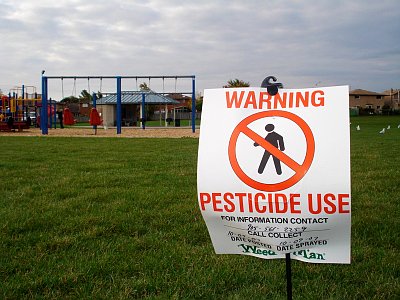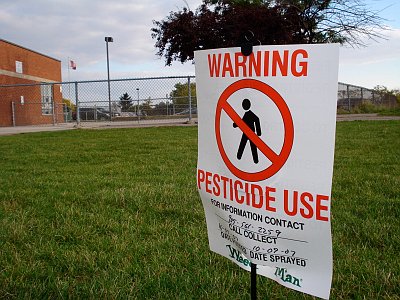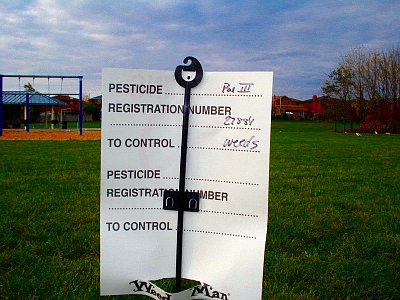What did we expect when we passed a law that bans pesticides - except for the reasons that people normally use pesticides?
By Trey Shaughnessy
Published October 22, 2007
On October 9, 2007, a pesticide company showed up on the sprawling lawns of Gordon Price and St. Vincent de Paul Elementary Schools and sprayed them with chemicals. On the morning of October 10, a strong odor came from the surrounding fields.

Pesticide Signs at Gordon Price and St. Vincent de Paul Schools
An email request to Gordon Price determined that the chemical sprayed was to control 'weeds'. Weeds are what we call indigenous plants. Kentucky Bluegrass does not naturally grow in our climate without the help of fertilizers and pesticides. The 'grass' that we think of growing on our soil would eventually lose out to the indigenous plants (weeds) that grow naturally to this area and climate.
Last month, in another 1950s manoeuvre, City Council decided to enter the future in theory, but in action remained in the past. Council passed a by-law that prohibits the use of pesticides - except for the reasons that people normally use pesticides.
A person would be in violation if they sprayed pesticide on their cereal but not on their lawns to control weeds or insects. To make sure golf courses were exempt, a blanket exemption of 'public land' was written, which is why chemicals continue to be sprayed on the playgrounds were children take their 'nutrition breaks' for 'exercise'.
On October 10, the children of Gordon Price and St. Vincent de Paul schools were 'advised' by the signs shown not to walk on the grass. So much for exercise that day.

Pesticide Signs at Gordon Price and St. Vincent de Paul Schools
If there was a reason to pass a by-law in the first place (and there is strong evidence for just that), why make it so weak that nothing will change?
Children will still walk on the grass and track the chemicals into their homes, play, fall down, and pick and throw grass on each other.
The idea of making our yards and parks toxic to everything but the unnatural plants that grows on them is absurd and needs a wake up call. If we always do what we've always done, then we'll always get what we've always got.

Pesticide Signs at Gordon Price and St. Vincent de Paul Schools
Thanks to Melissa S. for the photos.
By adrian (registered) | Posted October 24, 2007 at 09:22:51
There's a simple way to judge the effectiveness of this bylaw (and the anti-idling bylaw):
If the activity is deemed to be common enough, and dangerous enough, that a bylaw prohibiting the activity is required, then the measure of its effectiveness is the degree to which the activity ceases after the bylaw is enacted.
By that measure, it seems clear to me that the anti-idling bylaw is a total failure. I saw all sorts of people idling before the bylaw. I still see all sorts of people idling after the bylaw.
There is no apparent difference in the level of idling, thus, the anti-idling bylaw is a failure.
It remains to be seen what will happen with this bylaw, but from the sounds of it, we may expect similar results.
By chicago (anonymous) | Posted October 24, 2007 at 11:18:52
if you're judging on THOSE grounds it was doomed from the start, that's the wrong way to test this. the important thing is whether council LOOKS LIKE they're doing the right thing. on that score they both pass with flying colors!
By Leisha (anonymous) | Posted October 27, 2007 at 16:43:55
By-laws, like any laws, need to be enforced by the government on behalf of its citizens. The municipal government has chosen to educate the citizens before any true enforcement starts. It is disappointing and discouraging that the step to educate people has not begun. I can only speculate what will encourage the municipal government to act on its by-laws. More school children pleading for help during council meetings?
By Practical (anonymous) | Posted November 05, 2007 at 08:41:14
In response to the articale bt Tevor Shaw...on Pesticide use ...the intent was to REDUCE the use and where possible and practical eliminate the ise of Pesticides/Herbicides.
This may be practical on small land masses like the frontlawns of residential homes and small commercial properties....but not PRACTICAL for very large land owners sucj as farmers, sod farms, Golf courses or acres and acres of civic parklands...
The City has come up with what i think is a very PRACYICAL and REALISTIC by-law....that willlead tot he reduction in pesticed usage....elimination which seems to be the ultimate goal of misinformed individuals and some groups....is just not PRATICAL or REASONABLE or responsible from an economic impact to the already overburdoned taxpayers
By trey (registered) | Posted November 07, 2007 at 11:32:08
Practical. What you are saying is a total elimination of a carcinogen is unpractical and/or impossible.
Sort of like only partially breathing asbestos or only smoking half a pack a day. Eliminating a danger is not practical? This by-law won't change anything, just like the idling by-law, they will have no effect on people's health. And for what? Green lawns.
There will be a day, just not today, when an enlightened generation honestly weighs pros and cons of our activities of daily living.
By Practical (anonymous) | Posted November 08, 2007 at 08:01:43
Unfourtunatley in this day and age all products.... wood, cement, asphalt, food products, plastics, polycarbonates, cosmetics,shampoos, hydro transmission lines etc etc. are all sited as having adverse health effects and potenial carcenogenic affects...
Again a balanced approach to Pesticides and Herbicide usage that leads to REDUCTION...and ELIMINATION where Practical....is a good approach which this by-law addresses and will lead to the pesticide/herbicide reduction awareness and as a result will provide consistentcy in the application of rules and regulations(Provincial and Municiple) to all users.....which is a giant step forward in the REDUCTION of the use.....as noted in the by-law....all aplicators will have to be IPM accredited....in order to apply pesticides....Integrated Pest Management (IPM) promotes the use of Horticultural practices first and foremost....and the use of Pesticides /Herbicide as a means of LAST resort....which in itself ...will force the REDUCTION and use of these necessary (under certian conditions)products...
By trey (registered) | Posted November 08, 2007 at 10:49:46
pesticides and wood are equally dangerous?
So everything is dangerous 'in this day and age' so let's just forget about safety and mitigating any hazardous substances. In fact let's allow lead paint in Canada, let's go back to smoking everywhere, let's forget about leash laws, let's take down all speed limits, let's forget about WHIMIS, That doesn't makes sense. Bottom line is it's a dangerous substance and has no place being on lawns and playgrounds. The benefit of a green, weed-free lawn DOES NOT out way the cancer it causes. Smoking in public and drinking and driving are just two examples dangerous behaviours that have been banned. It's just time now for cosmetic pesticides to go the same route.
I guess we'll have to wait for McQuinty to make a province-wide ban.
By Practical (anonymous) | Posted November 11, 2007 at 08:23:06
My Point was ....there are 100's of products being produced now that have or may have an impact on humans and animals...some of which are necessary in this day and age...
If you actually follow the science of this topic...the jury is out on it's affects....for every study indicating the products safety...there is another indicating it's ill effects...
It seems to me that the largest user of these products is the agricultural community....but every by-law in every city in Canada...has exempted Fariming or Agriculture from those by-laws....as Provincial legislation cannot be over ridden by a municipal by-law....
If a provincial ban was to occur in Ontario....I'm sure Agriculatue will get a "free Pass' as the fod osurce has to be protected to feed the masses.....being Practical.....I understand this....as the crop yield would not sustain the masses if all farming and agriculture were banned from using Pesticides or Herbicides....
This by -law will have a positive effect in EDUCATING homwowners and in fact limit them from unecessary use of these products....there by REDUCING the the amount used ....thereby....REDUCING the potential negative effects...
Again I disagree with the oringional comments....about the By-law PROVING TO BE WORTHLESS
By trey (registered) | Posted November 14, 2007 at 10:42:09
NO THE JURY IS NOT OUT. this is propaganda from the Weedman's of the world. Let's stick to facts.
Epidemiological studies have shown that home use of pesticides is associated with increased cancer risks in children.
Three studies quoted below for your facts.
A study by Jonathan Buckley and colleagues from the Children's Cancer Group found that children who had been exposed (in utero and in early childhood) to household pesticides and professional extermination methods within the home were three to seven times more likely to develop non-Hodgkin's lymphoma compared with children who had not been exposed. The more pesticide exposure the children had, the higher their lymphoma rates.[5]
James Davis and research associates from the Missouri Department of Health and the University of California-Berkeley, have found that the risk of childhood brain cancer increased more than five-fold in families that used pesticide bombs, no-pest strips and flea collars in or around the home. Brain cancer also posed an elevated risk in families that used pesticides to control garden insects, termites, head lice and garden weeds.[6]
In an article critically reviewing 31 studies published between 1970 and 1996, Julie Daniels, Andrew Olshan and David Savitz of the Department of Epidemiology, School of Public Health, University of North Carolina, assessed the risk of childhood cancer associated with exposure to pesticides through parental occupation or by residential use. [7] Daniels and her colleagues observed that childhood brain cancer and leukemia were the cancers most studied and that the researchers had found "fairly consistent, moderate increases in risk." [8]
The Cancer-pesticide link is stronger but there is also evidence for a pesticide-neurotoxin link in young children who are particularly more at risk because their brain is still developing.
Regarding the agri-use. I am well aware of the green-revolution and crop yields. No one is asking that farms stop using it. Only that inside cities, parks, residential lawns and cosmetic use be banned. Dandelions or Cancer? You decide.
The by-law IS useless and McQuinty will have to rescue us from a totally preventable cancer and neurotoxin risk. As for your 'awareness' to reduce the use... just look at the photos in this article... and ask yourself how much reduction is occurring?
By trey (registered) | Posted November 14, 2007 at 10:48:06
you missed the point too. Just because there are 100s of hazardous products in use today, it doesn't change the fact that pesticides are hazardous.
Should we try to eliminate some of these hazardous products? or should we increase the use of hazardous products?
The PRACTICAL thing to do is start eliminating the products and behaviours that are unnecessary.
By trey (registered) | Posted November 14, 2007 at 10:55:35
Show one example where this by-law did any educating.
The city's own staff who answer 546-CITY isn't even aware of the anti-idling and sign by-laws. In fact Municipal Enforcement doesn't know how to act to a by-law that is 'complaint based enforced'. That is, they will act ONLY when a complaint/call is made from a citizen. Just try and call 546-CITY, ask for Municipal Enforcement and make a complaint about a Mobile Sign that has been up for more than 90 days, or tell them a car has been idling for more than 3 minutes outside a school or tell them your neighbour's lawn has just been sprayed by Weedman..... nothing will happen... the city is a joke the by-law is a joke. it's nothing but lip service.
The school administration also had no idea when called about this that there was a by-law. Which there isn't really because public parks are exempt..... useless
By Practical (anonymous) | Posted November 21, 2007 at 08:44:33
Trey....for your information and the FACTS and for anyone eles who needs the FACTS Please visit www.24d.org.......even the World Health Organization agrees !!!!
By Trey (registered) | Posted November 27, 2007 at 16:13:11
o look a website designed for the chemical companies and the companies that do their bidding (ie WeedMan), to make sure we continue to consume their poison.
2,4-D was invented during the Second World War solely for military purposes, widespread use of this herbicide on suburban lawns in Canada dates only to the post-Vietnam War period, when the accumulation of Agent Orange's two ingredients--herbicides 2,4,5-T and 2,4-D--prompted chemical companies to seek a lucrative disposal for these synthetic substances after the military stopped buying it to defoliate the jungles of Vietnam.
http://en.wikipedia.org/wiki/Agent_Orang...
Agent Orange, given its name from the 55 U.S. gallon orange-striped barrels it was shipped in, is a roughly 1:1 mixture of two phenoxy herbicides in ester form, 2,4-dichlorophenoxyacetic acid (2,4-D) and 2,4,5-trichlorophenoxyacetic acid (2,4,5-T).
The International Agency for Research on Cancer (IARC) has classified 2,4-D among the phenoxy acid herbicides MCPA and 2,4,5-T as a class 2B carcinogen-possibly carcinogenic to humans. (IARC monographs on the evaluation of carcinogenic risks to humans: An updating of IARC Monographs volumes 1 to 42. Supplement 7, WHO, Lyon, France 1987.)
Proper application of herbicide protects the applicator, but has no effect on the toxicity of the product. After all, it is meant to be toxic and kills precisely when used as directed.
Concern over 2,4-D is such that it is currently not approved for use on lawns and gardens in Sweden, Denmark, Norway, Kuwait and the Canadian province of Québec. 2,4-D use is severely restricted in the country of Belize. In Canada, well over 135 municipalities have placed bylaws that restrict the cosmetic use of pesticides, including the use of herbicides containing 2,4-D. Include Hamilton in that 135 municipalities, although the city has decided it's okay to spray on playgrounds, but agrees that their use should be controlled -- a rather odd set of values.
By trey (registered) | Posted April 30, 2008 at 19:55:12
"I guess we'll have to wait for McQuinty to make a province-wide ban."
posted November 8, 2007 and guess what happened? McQuinty had to act on behalf of all Ontario because their lame-duck municipalities couldn't and banned the stuff.
Thank you Dalton.
By D-VAN (anonymous) | Posted May 02, 2008 at 11:45:12
k gordon price is an awesome school how come this site has so much stuff against it? :S
By u duuno (anonymous) | Posted June 08, 2009 at 13:59:51
seriously why why why clap clap clap tap tap tap
You must be logged in to comment.
There are no upcoming events right now.
Why not post one?